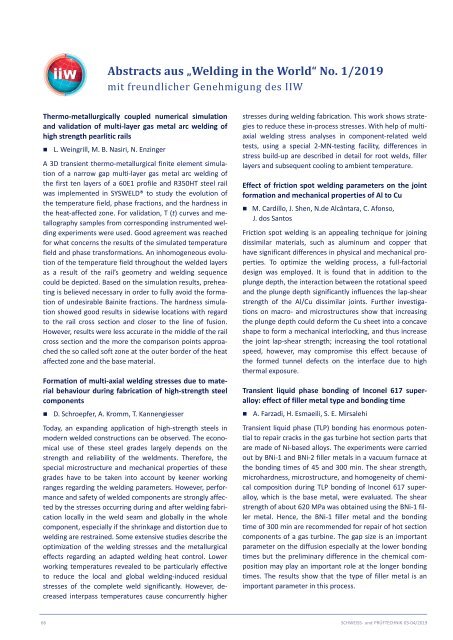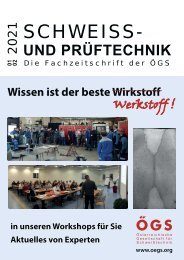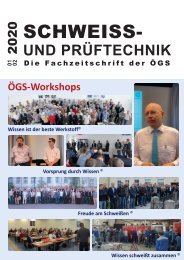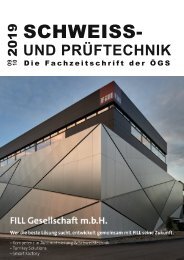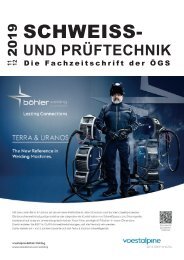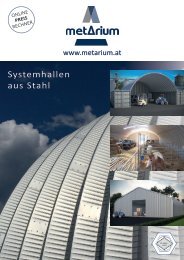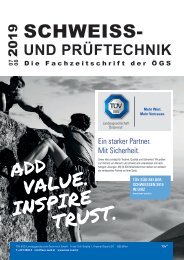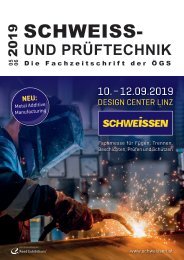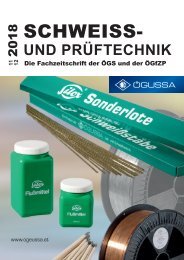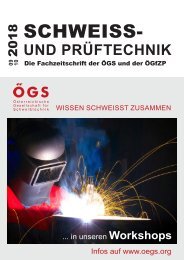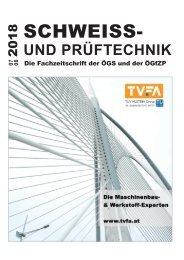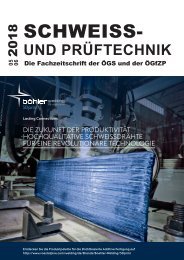Fachzeitschrift_OeGS_03_04_2019
Sie wollen auch ein ePaper? Erhöhen Sie die Reichweite Ihrer Titel.
YUMPU macht aus Druck-PDFs automatisch weboptimierte ePaper, die Google liebt.
Abstracts aus „Welding in the World“ No. 1/<strong>2019</strong><br />
mit freundlicher Genehmigung des IIW<br />
Thermo-metallurgically coupled numerical simulation<br />
and validation of multi-layer gas metal arc welding of<br />
high strength pearlitic rails<br />
• L. Weingrill, M. B. Nasiri, N. Enzinger<br />
A 3D transient thermo-metallurgical finite element simulation<br />
of a narrow gap multi-layer gas metal arc welding of<br />
the first ten layers of a 60E1 profile and R350HT steel rail<br />
was implemented in SYSWELD® to study the evolution of<br />
the temperature field, phase fractions, and the hardness in<br />
the heat-affected zone. For validation, T (t) curves and metallography<br />
samples from corresponding instrumented welding<br />
experiments were used. Good agreement was reached<br />
for what concerns the results of the simulated temperature<br />
field and phase transformations. An inhomogeneous evolution<br />
of the temperature field throughout the welded layers<br />
as a result of the rail’s geometry and welding sequence<br />
could be depicted. Based on the simulation results, preheating<br />
is believed necessary in order to fully avoid the formation<br />
of undesirable Bainite fractions. The hardness simulation<br />
showed good results in sidewise locations with regard<br />
to the rail cross section and closer to the line of fusion.<br />
However, results were less accurate in the middle of the rail<br />
cross section and the more the comparison points approached<br />
the so called soft zone at the outer border of the heat<br />
affected zone and the base material.<br />
Formation of multi-axial welding stresses due to material<br />
behaviour during fabrication of high-strength steel<br />
components<br />
• D. Schroepfer, A. Kromm, T. Kannengiesser<br />
Today, an expanding application of high-strength steels in<br />
modern welded constructions can be observed. The economical<br />
use of these steel grades largely depends on the<br />
strength and reliability of the weldments. Therefore, the<br />
special microstructure and mechanical properties of these<br />
grades have to be taken into account by keener working<br />
ranges regarding the welding parameters. However, performance<br />
and safety of welded components are strongly affected<br />
by the stresses occurring during and after welding fabrication<br />
locally in the weld seam and globally in the whole<br />
component, especially if the shrinkage and distortion due to<br />
welding are restrained. Some extensive studies describe the<br />
optimization of the welding stresses and the metallurgical<br />
effects regarding an adapted welding heat control. Lower<br />
working temperatures revealed to be particularly effective<br />
to reduce the local and global welding-induced residual<br />
stresses of the complete weld significantly. However, decreased<br />
interpass temperatures cause concurrently higher<br />
stresses during welding fabrication. This work shows strategies<br />
to reduce these in-process stresses. With help of multiaxial<br />
welding stress analyses in component-related weld<br />
tests, using a special 2-MN-testing facility, differences in<br />
stress build-up are described in detail for root welds, filler<br />
layers and subsequent cooling to ambient temperature.<br />
Effect of friction spot welding parameters on the joint<br />
formation and mechanical properties of Al to Cu<br />
• M. Cardillo, J. Shen, N.de Alcântara, C. Afonso,<br />
J. dos Santos<br />
Friction spot welding is an appealing technique for joining<br />
dissimilar materials, such as aluminum and copper that<br />
have significant differences in physical and mechanical properties.<br />
To optimize the welding process, a full-factorial<br />
design was employed. It is found that in addition to the<br />
plunge depth, the interaction between the rotational speed<br />
and the plunge depth significantly influences the lap-shear<br />
strength of the Al/Cu dissimilar joints. Further investigations<br />
on macro- and microstructures show that increasing<br />
the plunge depth could deform the Cu sheet into a concave<br />
shape to form a mechanical interlocking, and thus increase<br />
the joint lap-shear strength; increasing the tool rotational<br />
speed, however, may compromise this effect because of<br />
the formed tunnel defects on the interface due to high<br />
thermal exposure.<br />
Transient liquid phase bonding of Inconel 617 superalloy:<br />
effect of filler metal type and bonding time<br />
• A. Farzadi, H. Esmaeili, S. E. Mirsalehi<br />
Transient liquid phase (TLP) bonding has enormous potential<br />
to repair cracks in the gas turbine hot section parts that<br />
are made of Ni-based alloys. The experiments were carried<br />
out by BNi-1 and BNi-2 filler metals in a vacuum furnace at<br />
the bonding times of 45 and 300 min. The shear strength,<br />
microhardness, microstructure, and homogeneity of chemical<br />
composition during TLP bonding of Inconel 617 superalloy,<br />
which is the base metal, were evaluated. The shear<br />
strength of about 620 MPa was obtained using the BNi-1 filler<br />
metal. Hence, the BNi-1 filler metal and the bonding<br />
time of 300 min are recommended for repair of hot section<br />
components of a gas turbine. The gap size is an important<br />
parameter on the diffusion especially at the lower bonding<br />
times but the preliminary difference in the chemical composition<br />
may play an important role at the longer bonding<br />
times. The results show that the type of filler metal is an<br />
important parameter in this process.<br />
66 SCHWEISS- und PRÜFTECHNIK <strong>03</strong>-<strong>04</strong>/<strong>2019</strong>


